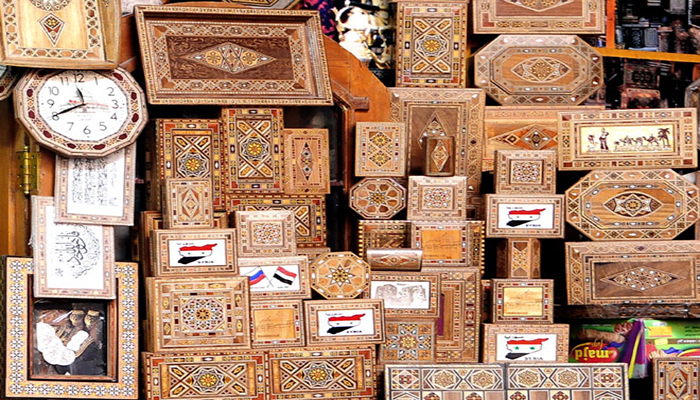Syria is known for many handicrafts that are special to it exclusively, but the passage of time and the ambiance of the war brought many of the old handicrafts out of the picture, especially young men traveling out of that country, which made it hard to maintain this art.
But still let’s get to discover more about this magical handicraft:
The Damascene mosaic industry is one of the oldest professions for which the city of Damascus is still famous for, the known history of this industry goes back at least 700 years, it was active during the Turkish period, when the makers of this craft in Damascus were transferred to Astana, but, despite that, its industry continued in the Levant thanks to skilled craftsmen.
The city of Damascus is famous for making wood inlays or mosaics, which is a special Damascene art. Jerji Al-Bitar is considered the first to innovate this industry when he made the first piece of mosaic in 1860 by collecting bars of naturally colored wood with triangular or square shapes, then cutting them in the form of chips and gluing them to the woodwork with natural glue.
This craft began in the capital, Damascus, due to its proximity to the Ghouta area whose orchards are rich in various types of wood of various colors. Each type of wood has a different color, this is the basis of the mosaic craft, which was launched in that period and began to develop and introduce new additions in subsequent periods.
The art of inlaying wood with seashells, or what is called mosaic, is the insertion of seashells into particles of different types of wood. Mosaic art relies entirely on manual work, as the wood is cut into small sticks that form a bundle of different types and colors, which are cut into slices that are combined together to form the desired shape, so that many pieces in the form of squares, triangles, or seashells are collected in one piece forming a beautiful mosaic.
The art of mosaic was developed by a creative Damascene craftsman, Jerji Bitar, who invented in the nineteenth century the method of inlaying wood with wood, and established a center for mosaic mangroves that included dozens of workers who learned this beautiful art from him. Also, more than a thousand famous craftsmen graduated from his workshop, and this number of craftsmen led to the spread of the products of this art and its commercial popularity inside and outside Syria.
The Maters of this art, also known as “sheikhs of the Karr”, in the mosaic craft in Damascus assert that this craft is characterized first as a handcraft with distinction that requires patience and forbearance, in addition to an aesthetic vision that relies on its raw materials on the various woods of trees Damascus Ghouta area, including cypress, apricot, lemon, walnut and beech, from which the wooden slices are pulled to be collected in any geometric shape, such as a small or large star to be dissected later to become thin slices from which the wood is inlaid in different shapes to form a beautiful painting.
Mosaic artisans in Damascus confirm that the teacher, Jerji, made a great leap in the mosaic craft, and he was credited with teaching hundreds of students who mastered this craft and developed it after him by inserting shells, animal bones and ivory into wooden decorations.
Moreover, one of the sheikhs of karr of the mosaic art warns of the danger of the extinction of this profession that distinguishes Damascus, and of the difficulty of preserving it, saying: The number of workers in this craft decreased after many young men traveled abroad, due to the effort required by this profession, as preparing the piece takes from two weeks to a month, as well as the high costs of its manufacture and the difficulty of marketing its products.
Leen Al Salman

